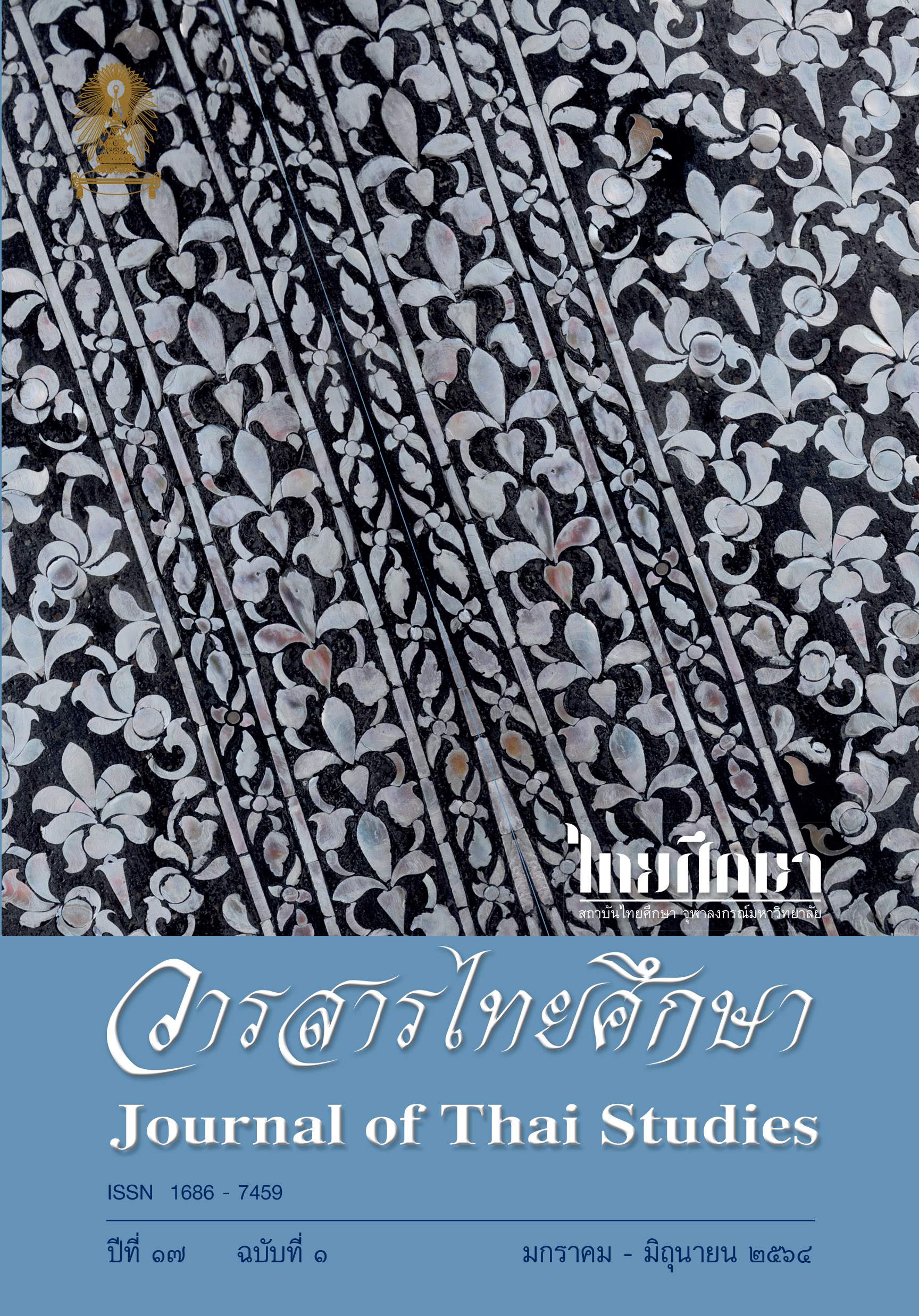The Comparison Between Thai and Korea Mother of Pearl Inlay
Main Article Content
Abstract
In East Asia and Southeast Asia, there has been mother of pearl inlay for more than a thousand years. Such work combines science and arts using materials from the land and sea, which are lacquer varnish and pearl oysters used by artisans of lacquer and mother of pearl inlay. Mother of pearl inlay appears in China, Japan, Korea, Thailand, Vietnam, Myanmar, Laos and Cambodia. Many books and academic articles in Thailand provide information about mother of pearl inlay in China, Japan and Vietnam, but only a few include information about the work in Korea. Accordingly, this article compares the differences between mother of pearl inlay in Thailand and Korea in terms of materials, tools, motifs, techniques and uses. The students in fine arts, history and cultural studies can learn about the origins and values of Thai and Korean mother of pearl inlay that reflects ways of life, societies and cultures. Furthermore, Thai mother of pearl inlay artists have used some particular techniques and motifs to create a new platform that can conserve traditional art in combination with contemporary art.
Downloads
Article Details

This work is licensed under a Creative Commons Attribution-NonCommercial-NoDerivatives 4.0 International License.
Journal of Thai studies is licensed under a Creative Commons Attribution-Noncommercial-NoDerivatives4.0 Intenational (CC BY-NC-ND 4.0) licence, unless otherwise stated. Plese read our Policies page for more information on Open Access, copyright and permissions.
References
Boonjaeng, S. (2018). Laksana chapor kong yang lak yai lae karn yeudtid bon peunpil ceramic. [Characterization of Gluta Usitata Sap and adhesion on ceramic surfaces]. (Master degree dissertation). Chiang Mai Rajabhat University, Chiangmai, Thailand.
Choi, Y. (1998). Arts of Korea. New York: The Metropolitan Museum of Art, Yale University Press.
Choi, Y. (2001). Goryeo Dynasty Lacquerware with mother of pearl inlay. Seoul: Chungnam University.
Contemporary Korean Crafts exhibition. (2015). Ottchil: Korean Lacquer. Seoul: Korea craft & design foundation.
Fine Arts Department. (2008). Boranstan nai changwat Phra Nakhon Sri Ayuddhaya [Archaeological sites in Phra Nakhon Sri Ayutthaya Province]. Bangkok: Ministry of Culture.
Hwang, J. (2010). Korean lacquerware inlaid with mother-of-pearl: the everlasting beauty. Seoul: National Museum of Korea.
Hwang, J. and Kawada, S. (2010). Korean lacquerware inlaid with mother-ofpearl: the everlasting beauty. Seoul: National Museum of Korea.
Institute of Ayuddhaya Study. (2014). Ekkasan prakob krongkarn laokan prawatsat Borombuddharam yon ramruek wanwan yan pratong. [History of Borombuddharam Temple: The recognize of the Phatong Area Project]. Phanakornsri Ayuddhaya: Phanakornsri Ayutthaya Rajabhat University.
Jamornman, O. (2020). Boransil malang malueang leubleuam rueang rong rung [The rainbow brilliant ancient art]. Booklet of Tourist Organization of Thailand, 60 (6), 110-111.
Jeju National Museum. (2014). Jeju National Museum exhibits rare mother-of-pearl lacquerware. Jeju: Korea.net.
Khumkaew, P. (2020). Karn seuksa silpakham ngan phadabmukthai. [A study Thai mother of pearl inlay for altar set design]. (An independence study). Master of science in technology education, King Mongkut’s Institute of Technology Ladkrabang, Bangkok, Thailand.
Komolbut, S. (2002). Jodmaihet karn derntang su pratej siam kong batluang takarn [Journal of the journey of Guy Tachard to Siam]. Bangkok: Aksorncharoentat Printing.
Kritchanavin, M. (2014). Pattana karn rae karn poenpang kong ngan pradabmook in praneetsil thai. [Development andchanges to mother of pearl inlay in Thai minor arts]. (An independence study). Master of arts program in arts history, Silpakorn University, Bangkok, Thailand.
Lee, E. (2019). Mother of pearl: Dazing color of nature. Korea: national folk museum of Korea.
Lee, J. (1985). Lacquerware in the unified Silla period with special reference to the find at Anap-chi. Tokyo: The Urushi Study Group.
Lee, N. (2003). A technical analysis of a Goryeo dynasty lacquer incense box in the collection of the national museum of Korea. Leiden: brill.com.
National Museum of Korea. (2011). Lacquered Comb Box Inlaid with Mother-of-pearl. Seoul: NMK’s magazine.
Natsu, O. (2007). Recent museum of art acquisition: Korean lacquer box. Michigan: Asian Art University of Michigan Museum of Art.
Park, S. (2002). Lacquerware in Korea. Mayenne: UNESCO Publishing.
Roh, J. (2019). Korean lacquer work craftsmen who went to Japan. New York: Taylor & Francis.
Sadamu, K. (2008). Korean Najeonchilgi of the Goryeo and early Joseon periods. Seoul: National Museum of Korea.
Sammawutthi, A. (2015). Karn jas sang banpratu pradabmuk horphamantientham puea karn anurak ban pratu derm. [Mother of pearl doors at Phra Monthian Tham Hall]. Bangkok: Fine art department.
Sanprasert, C. (2002). Lai sanyalak bon banpratoo pradabmook samai ayuddhaya tonpai Buddha satrawat tee 23 [Symbolism onthe mother of pearl inlaid doors in the late Ayutthaya period, 17-18 A.D]. (An independence study). Master of arts program in arts history, Silpakorn University, Bangkok, Thailand.
Takata, T. (2016). Ngan pradab mook Ryukyu kanton karn sang [Ryukyu mother of pearl inlay: The creation process]. Bangkok: Siam University.
Thai Arts Academic Group, Ten divisions of traditional Thai crafts, Fine Arts Department. (2010). Kongkarn sang tonbab puea jadtam ongkhamrue dan ngan changphadabmook [Dissemination of mother of pearl inlay as a role model project]. Bangkok: Ten divisions of traditional Thai crafts, Fine Arts Department.


